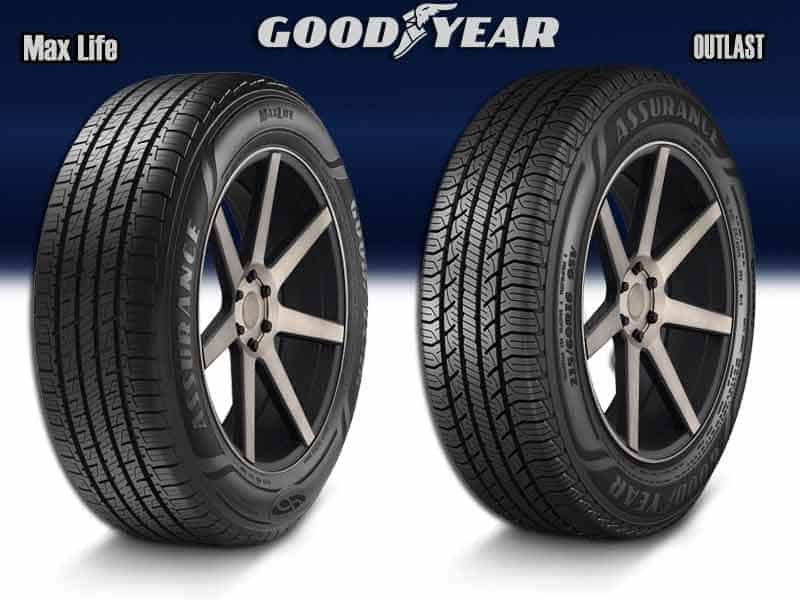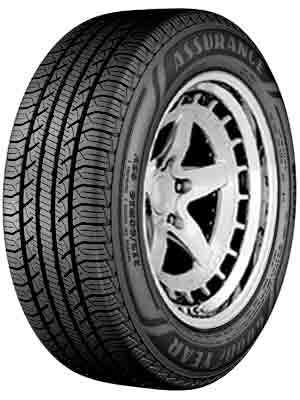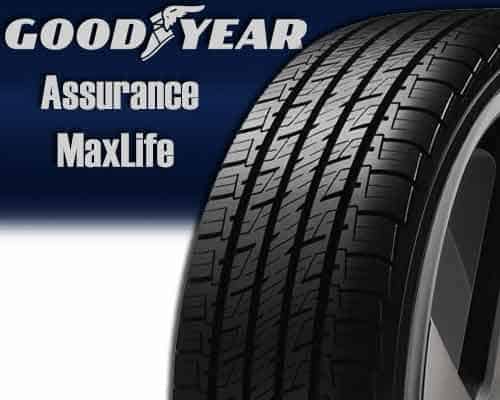Both are All-Season tires that are built to offer excellent performance in all weathers. However, upon comparing the size 205/55R16 of both the tires, we found a few noticeable differences.
While the overall traction of MaxLife is superior on dry, wet, and icy roads due to its narrower grooves and numerous sipes, the hydroplaning resistance of Outlast is better because of its higher void ratio.

However, these were not the only huge differences that we found. Want to know which tire offers better comfort and lower rolling resistance? Let’s dig in then!
Table of Contents
Comparing Goodyear Assurance Outlast with Assurance MaxLife
Goodyear Assurance Outlast

Goodyear Assurance MaxLife


Vs

Featuring an asymmetrical tread pattern, the Assurance Outlast features two outer shoulders and three central ribs sandwiched in between these shoulders. The ribs and the shoulders are separated by four deep longitudinal grooves running around the tread. However, the lateral grooves are missing from the tread pattern. In addition to this, the shoulders are broader in comparison and the shoulder blocks are also larger. Talking about the sipes, they are less on both the central part and the shoulder lugs.
The Assurance MaxLife also features an asymmetrical tread design to provide resistance against all the weathers. When it comes to the tread design, three central ribs can be found in between its two outer shoulders. Both the shoulders and the central ribs are separated by the narrower grooves running around the entire tread and numerous deep sipes are found all over the tire. In addition to this, the shoulders are also compact and the shoulder blocks are closely positioned.
Grip Comparision
Upon comparing both the tires, we found that the circumfrencial grooves of the Assurance Outlast are wider. As a result, its contact patch gets lower, resulting in poor performance on dry roads. Due to the higher void ratio, the braking distance is also increased. The same is the case with this tire’s performance on wet and icy roads. There are a fewer number of shallow sipes on the central part. So, this tire’s grip on these surfaces is also compromised, leading to a higher braking distance. However, due to the wider grooves, its gripping ability on snowy surfaces is higher, resulting in a better performance.
On the other hand, MaxLife offers a higher grip on dry roads due to its narrower grooves. In addition to this, its asymmetric tread pattern enhances the traction even more. As a result, the vehicle maintains its stability on dry surfaces and the braking distance is reduced. When it comes to the grip on wet roads, the numerous deep sipes work incredibly well to provide excellent performance on wet surfaces. So, the braking distance on wet tracks is also reduced. The same performance is translated on the icy roads as well. However, due to the lower void ratio of MaxLife, it is unable to maintain its grip on snowy surfaces and as a result, its performance on snowy roads is lower.
Handling Comparison
Talking about the handling performance of both these tires on dry roads, the Outlast loses to its opponent due to its open shoulder design. As a result, the time required by the vehicle to complete a lap on dry tracks is increased. The tire reflected the same performance on wet and icy surfaces as well. The sipes found on the shoulder blocks are not decent enough to maintain traction. Therefore, its performance on these tracks is compromised. However, when it comes to snowy surfaces, the wide shoulder design proves to be extremely helpful in increasing the biting edge of the tires. Thus, its performance on snow is remarkable.
In comparison, the dry handling of MaxLife is remarkable due to its compact shoulders and closely packed shoulder lugs. This results in increased grip and the drivers get premium handling on dry tracks. Due to this, the vehicle was able to complete a lap in relatively less time. In addition to this, we found deep and numerous sipes on the shoulder lugs which increased the tire’s handling capabilities on wet and icy tracks as well. However, the same performance was not witnessed when we took the vehicle on snow. The compact shoulders were unable to provide decent handling on a snowy surface and as a result, the time taken by the vehicle to finish a lap was increased.
Comparison of Hydroplaning Resistance
Outlast offers superior hydroplaning resistance on flooded roads. Its deep and wide grooves prove to be incredibly helpful in wiping away the water effectively. As a result, the chances of accidents are also reduced.
On the other hand, MaxLife loses to its competitor when it comes to hydroplaning resistance. That’s because these tires feature narrower grooves and as a result, their capacity to evacuate the water reduces. Due to this, it will face difficulty in moving ahead on flooded roads and the chances of accidents will increase.
Comparison of Rolling Resistance
The rolling resistance of a tire is directly proportional to its contact patch. In the case of Outlast, its higher void ratio indicates that less area of the tread will come in contact with the road. As a result, the friction will decrease and the lower rolling resistance will decrease. Not only this, but the fuel efficiency will also increase and the vehicle will get better mileage.
In comparison, the MaxProof features a higher contact patch due to its narrower grooves. As a result, more area of its tread will come in contact with the road’s surface and the rolling resistance will increase. Due to the higher rolling resistance, its fuel efficiency will also reduce.
Comfort Comparison
Due to the wider grooves present in the Outlast, there will be more space for the entrapment of air particles inside its voids. So, when the vehicle will move at a higher speed, these air particles will strike back and forth and as result, more noise will be produced. This is what makes them a less comfortable option to drive.
Comparatively, the MaxLife features narrower grooves than its competitor. So, the air particles will not have much space to be stuck inside and strike against the groove walls. Therefore, this tire will produce relatively less noise and you will get a comfortable ride even when driving the vehicle at high speed.
Durability & Treadwear
Outlast is a more durable option because of the high-quality materials such as the special silica compound used in its construction. So, even though the dry and wet traction of these tires is not as effective as compared to its opponent, the users will get a durable tire that will last for years. In addition to this, its tread will also wear out slower because of its lower rolling resistance.
On the other hand, the MaxLife is a comparatively less durable option since it features a higher rolling resistance. Moreover, this tire’s tread consists of a dual compound structure that enhances its overall traction. However, due to the enhanced traction, the tread also wears out faster.
Price
While the price range of both tires is nearly the same, MaxLife costs a few bucks higher than its competitor because of its enhanced traction and comfort. On the other hand, if you are in search of a more affordable option, the Outlast is a worthy option to consider because of its strong hydroplaning and lower rolling resistance.
Summary
- Both of them are All-Season tires.
- MaxLife displays a better grip and handling on dry, wet, and icy surfaces, however, the performance of Outlast on snowy tracks is superior.
- The hydroplaning resistance of Outlast is better.
- The rolling resistance of Outlast is also lower, leading to better fuel efficiency.
- The MaxLife is a more comfortable option to drive on roads.
- The tread of Outlast will wear out slower, adding more to its durability.
- MaxLife is a higher-priced tire.


